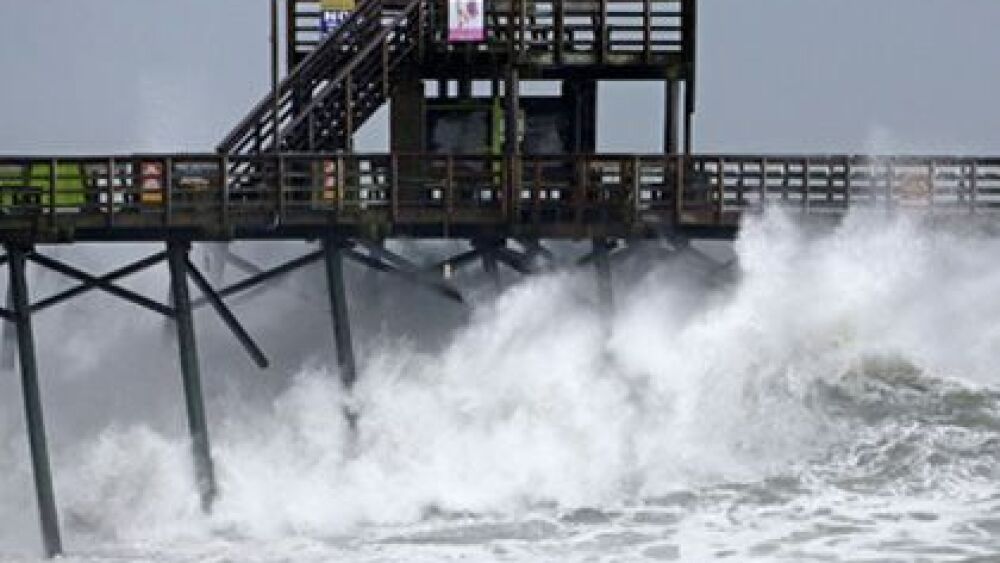UPDATE: (2:14 p.m. CST) –
WILMINGTON, N.C. — Mother, infant die in Wilmington, N.C. after tree falls on their home, becoming first fatalities caused by Florence.
EARLIER:
Associated Press
WILMINGTON, N.C. — Hurricane Florence rolled ashore in North Carolina with howling 90 mph winds and terrifying storm surge early Friday, splintering buildings and trapping hundreds of people in high water as it settled in for what could be a long and extraordinarily destructive drenching.
More than 60 people had to be pulled from a collapsing cinderblock motel. Hundreds more were rescued elsewhere from rising water. Others could only wait and hope someone would come for them.
“WE ARE COMING TO GET YOU,” the city of New Bern tweeted around 2 a.m. “You may need to move up to the second story, or to your attic, but WE ARE COMING TO GET YOU.”
As the giant, 400-mile-wide hurricane pounded away, it unloaded heavy rain, flattened trees, chewed up roads and knocked out power to more than 600,000 homes and businesses.
There were no immediate reports of any deaths.
https://twitter.com/USATODAY/status/1040596806688796672
The biggest danger, as forecasters saw it, was not the wind but the water: the storm surge along the coastline and the prospect of 1 to 3½ feet of rain over the next several days that could trigger catastrophic flooding in a slow-motion disaster well inland.
By early afternoon, Florence’s winds had weakened to 75 mph, just barely a hurricane and well below the storm’s terrifying Category 4 peak of 140 mph earlier in the week. But the hurricane had slowed to a crawl as it traced the North Carolina-South Carolina shoreline, drenching coastal communities for hours on end.
https://twitter.com/BBCWorld/status/1040594444087517190
Authorities warned, too, of the threat of mudslides and the risk of environmental havoc from floodwaters washing over industrial waste sites and hog farms.
Florence was seen as a major test for the Federal Emergency Management Agency, which was heavily criticized as slow and unprepared last year for Hurricane Maria in Puerto Rico, where the storm was blamed for nearly 3,000 deaths in the desperate aftermath.
The National Hurricane Center said Florence will eventually make a right hook to the northeast over the southern Appalachians, moving into the mid-Atlantic states and New England as a tropical depression by the middle of next week.
Meteorologist Ryan Maue of weathermodels.com said Florence could dump a staggering 18 trillion gallons of rain over a week on North Carolina, South Carolinas, Virginia, Georgia, Tennessee, Kentucky and Maryland. That’s enough to fill the Chesapeake Bay or cover the entire state of Texas with nearly 4 inches (10 centimeters) of water, he calculated.
North Carolina alone is forecast to get 9.6 trillion gallons, enough to cover the Tar Heel state to a depth of about 10 inches (25 centimeters).
On Friday, coastal streets in the Carolinas flowed with frothy ocean water, and pieces of torn-apart buildings flew through the air. The few cars out on a main street in Wilmington had to swerve to avoid fallen trees, metal debris and power lines. Traffic lights out of order because of power failures swayed in the gusty wind. Roof shingles were peeled off a hotel.
The Wilmington airport had a wind gust clocked at 105 mph (169 kph), the highest since Hurricane Helene in 1958.
Airlines canceled more than 2,100 flights through Sunday.
https://twitter.com/TODAYshow/status/1040586724584435712
In Jacksonville, North Carolina, next to Camp Lejeune, firefighters and police fought wind and rain as they went door-to-door to pull people out of the Triangle Motor Inn after the structure began to crumble and the roof started to collapse.
In New Bern, population 29,000, flooding on the Neuse River trapped people, and Mayor Dana Outlaw told The Charlotte Observer that about 200 had been rescued by 5 a.m. Residents reached out for help through the night by phone and social media.
Tom Balance, owner of a seafood restaurant in New Bern, had decided against evacuating his home and was soon alarmed to see waves coming off the Neuse and the water getting higher and higher. Six sheriff’s officers came to his house to rescue him Friday morning, but he didn’t need to leave since the water was dropping by then.
Still, he said: “I feel like the dumbest human being who ever walked the face of the earth.”
https://twitter.com/GarrettHaake/status/1040562170646417409
Sheets of rain splattered against windows of a hotel before daybreak in Wilmington, where Sandie Orsa of Wilmington sat in a lobby lit by emergency lights after the electricity went out.
“Very eerie, the wind howling, the rain blowing sideways, debris flying,” said Orsa, who lives nearby and feared splintering trees would pummel her house.
More than 12,000 people were in shelters in North Carolina and 400 in Virginia, where the forecast was less dire. Officials said some 1.7 million people in the Carolinas and Virginia were warned to evacuate, but it was unclear how many did.
More than 3,000 inmates at North Carolina prisons and juvenile detention centers were moved out of the storm’s path.












